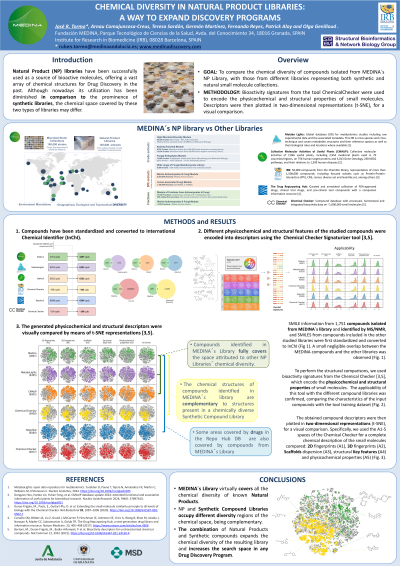Screening Applications & Diagnostics
Poster Session B
(1113-B) Chemical diversity in Natural Product Libraries: a way to expand Discovery Programs
Wednesday, May 29, 2024
10:30 - 11:15 CEST
Location: Exhibit Hall

- JT
Jose R. Tormo, PhD (he/him/his)
Associate Area Head Chemistry
Fundacion MEDINA
Granada, Andalucia, Spain
Poster Presenter(s)
Abstract: Natural Product (NP) libraries have been successfully used as source of bioactive molecules, offering a vast array of chemical structures for Drug Discovery in the past. Although nowadays, its utilization has been diminished in comparison to the prominence of synthetic libraries, the chemical space covered by these two types of libraries may differ. To assess their chemical diversity, we compared compounds isolated from MEDINA´s NP Library (one of the largest microbial extract libraries worldwide) with those from different libraries representing both synthetic and natural small molecule collections, containing approved drugs (Repohub), highly diverse synthetic compounds (IRB Chemical Diversity), plant extracts (CMAUP) and bacterial metabolites (MetaboLights). To perform the comparisons, we used bioactivity signatures from the ChemicalChecker [1,2], which encode the physicochemical and structural properties of small molecules, and plotted them in two-dimensional representations (t-SNE), for a visual comparison. Our analyses show that: (1) MEDINA´s Library virtually covers all the chemical diversity of known Natural Products and, (2) that NP and synthetic compound libraries occupy different diversity regions of the chemical space, being complementary. Overall, we suggest that a combination of natural products and synthetic compounds expand the chemical diversity of the resulting library, increasing the search space in any Discovery Program.
[1] Duran-Frigola et al. 2020. Nat Biotechnol https://doi.org/10.1038/s41587-020-0502-7
[2] Bertoni et al. 2021. Nat Commun https://doi.org/10.1038/s41467-021-24150-4
[1] Duran-Frigola et al. 2020. Nat Biotechnol https://doi.org/10.1038/s41587-020-0502-7
[2] Bertoni et al. 2021. Nat Commun https://doi.org/10.1038/s41467-021-24150-4
